Long range shooting, whether you like it or not, is here to stay, and I am happy about that. The shooting industry has made huge technical advancements in optics, laser rangefinders, and the general overall accuracy of most brands of rifles.
We now can hit something in a different zip code. What seemed impossible a short time ago can now be done consistently. With that being said, I personally want to take advantage of knowing what can and will help me to achieve my long range shooting goals.
The fundamentals of long range shooting need to be reinforced to prevent bad habits and to serve as a basis upon which to build your confidence and abilities. No matter what level of ability you possess; the basics of sight alignment, trigger squeeze, breathing, and follow through remains the same.
You can never eradicate "wobble," but you can minimize it through technique, practice, physical conditioning, and using your surroundings.
How to Be a Spotter
Whether you are pursuing an adversary or quarry, each individual in a shooter and spotter team has an important role in getting the task accomplished. In order to function effectively, both individuals need to have a complete understanding of what is expected from each other.
Expectations of each person in a spotter team should include a common language, manipulative skills, specific spotter commands, and knowledge of physical limitations of each other.
When this is practiced, no misunderstandings or miscommunications should occur during the preparation to take the shot.
Let's break this down a little more.
Spotter Commands
Being in a hunting situation, we all know we should be as quiet as possible. The language we use to communicate should be in short form. Using as few words as possible reduces the possibility of being heard and gives the shooter or the spotter a very direct command. An example might sound like this, "Wind 5-6...full...left to right."
The following is an example of what NOT to do, "I'm getting a reading of about 5-6 mph...left to right...full value at nine o'clock.” These two statements give the same information, but one is much shorter and more concise. Always be as short and concise as possible. This gives the shooter all the necessary info without having to sort through all the extra verbiage.
Spotter Skills
This system takes a little practice before going on a hunt or competition. When it comes to manipulative skills, and being a shooting spotter, everyone is different. Some individuals want to make all of the adjustments on their own equipment while others might want help. Some scenarios might require assistance. An example of this would be when the shooter doesn't have the rifle or equipment capable of making the shot because of optic limitations, caliber, or distance. In this case, the guide or spotter might suggest that the shooter use his or her rifle. Now the shooter is handed a weapon he may or may not have shot. Being unfamiliar with this rifle and optics demands assistance.
When it comes to physical limitations, all parties should be made aware of everybody’s limitations or conditions before heading into the field. Bad knees, back injuries, overweight, respiratory problems, etc. All of these can have a negative impact if not addressed beforehand. Adjusting to these specific needs can help achieve a desirable outcome. Not being aware of these limitations can be disastrous.
The Role of the Spotter
The police SWAT team I have trained with the last 8-9 years, teaches its sniper teams (shooters) that their main job is to identify the target and remain on that target until given the command to engage. That's their only job.
All other preparations are to be done by their spotter. He or she is responsible for ranging, wind call, scope adjustments, etc. Of course, in a law enforcement situation, it could be a life-threatening deployment.
In redirecting or adjusting this article towards a less threatening or hunting scenario, we are not bound to follow set rules of engagement. We can easily deviate from this procedure to soften or make each individual more comfortable with his or her requirements.
As I pointed out earlier, all of these actions should be tried and assigned to each individual beforehand. There is no perfect plan, but a tried and practiced plan works better than an impromptu plan. It’s wise to know ahead of time what is expected of each other.
Spotter Techniques and Positions
At one time or another, we all have had to get out of the prone position to take or make a shot because of the vegetation and the topography, and when we leave the ground, we become less stable. The farther off the ground, the more unstable we become. All of us experience this. In this article, I'm going to explain a few techniques that will create more points of contact, enabling us to become more stable. By using your surroundings, equipment, and your hunting partner we can accomplish this task. Hearing and eye protection is required in all scenarios.
The following are a few techniques and photos showing how a spotter or hunting partner can assist the shooter with the shot preparation using mechanical aids along with your partner's body.
THE STANDING OR OFF-HAND POSITION
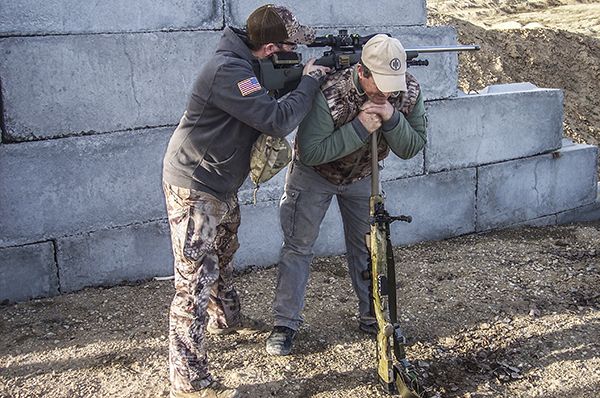
In the standing or off-hand position, you'll find that your limitations or hit probabilities drop tremendously, but there are a few things you can do to help better your odds.
In the photo, the shooter has his legs spread to shoulder width or slightly wider, giving him a firm foundation. His shooting partner is using his rifle (unloaded) to help stabilize not only his body, but the shooter's as well. Muzzle orientation and ear protection for both are a must in this and all sequences described in this article.
If shooting sticks were available, the assistant could then be used to support the trigger-hand elbow.
THE PARTNER-ASSIST POSITION
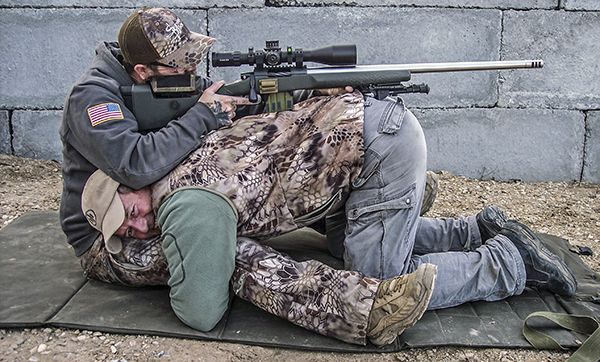
This position is quite, let's just say “unique,” to say the least! But it works quite well! The assistant gets into a somewhat fetal position, upon which the shooter grabs his partner's belt and pulls him into his body.
The SWAT team I train with learned and saw this technique being used in a competition in Austria a few years ago. Don't snicker or laugh till you try it. You'll be pleasantly surprised on how solid and stable you can get. If you can brace your back against something at the same time, it even gets better.
(Caution: if a bipod is attached to the rifle, be careful of your partner's back and tailbone.)
THE FENCE-POST ASSIST
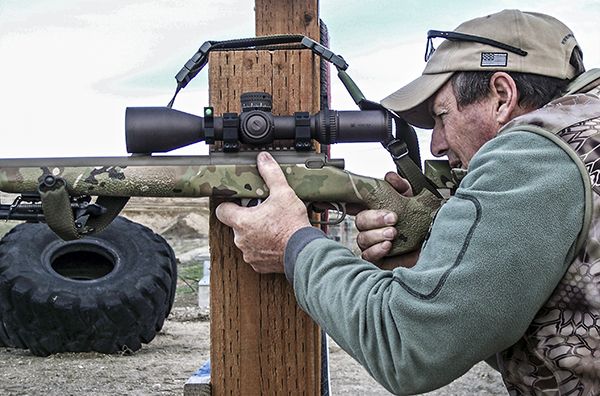
This is as simple as it looks. Simply throw the sling over a fence post, tree limb, stump, or whatever is available and adjust the length for the desired height.
Spotter Cautions
All of us have read articles explaining positional shooting, but when have you seen an article explaining how to use your equipment, vegetation, and your partner to assist you? Remember, the more points of contact the better!
Some of the photos might seem non-beneficial, but once you've tried them you'll immediately feel and see the difference. All of these sequences should be practiced before you go on your hunt or enter a competition. By doing this prior to your hunt, it will help determine what works best for you.
The Spotter Summary
In summary, don't wait to try these applications when you have a buck of a lifetime standing in front of you. Practice these procedures beforehand. Attend long range training courses and make sure you’re properly trained for the task at hand. At your shot presentation, be especially selective before you decide what position or technique to use. Look at ALL your surroundings and determine which will offer you the most points of contact, the more the better! All will help alleviate "wobble".
Remember: "We practice what we are good at; rarely do we practice what we are bad at."
At this time, I would like to thank my models, Dave and Nate. They aren't very cute...but they sure can shoot!
A TRIBUTE TO ED ROCHNOWSKI
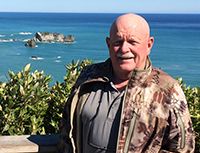
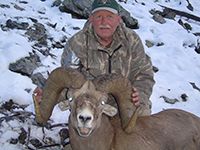
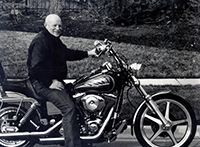
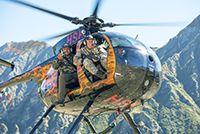
It was just over 10 years ago when shooting and long range enthusiast Ed Rochnowski approached Aaron Davidson of Gunwerks following a seminar in Salt Lake City. The seminar featured what would eventually change the landscape of modern hunting as we know it today - a riflescope featuring customizable ballistic turret technology.
I listened to this story at dinner at least one time every trade show season for the five years that I was privileged enough to spend on the road with Mr. Rochnowski. Ed approached Aaron and asked him if his invention really did what he claimed it was capable of doing. Aaron gave Ed his card and offered to send him a demo scope to try out and provide some engineering feedback on the first generation of the product. It wasn’t until weeks later that Ed came across Aaron’s card and decided to call him up and see if Aaron would make good on the offer that was extended to Ed in Salt Lake City that day following the seminar. It was that day that the relationship with Ed Rochnowski and Gunwerks was born.
Fast forward to the morning of October 21, 2015 when the phone rang in the front office. The voice on the other end delivered the bad news that our great partner in business and life-long friend had passed away.
I was fortunate enough to work very closely with Ed on an almost daily basis in my role of supporting our Gunwerks dealer network. Ed did a lot of great things in selling our products and promoting our brand, but his friendship will be the biggest void we will be forced to try and fill in one way or another going forward. Ed traveled with our company to trade shows across the country, assisted in our long range training courses, and consistently ranked in the top tier for our Gunwerks dealer network in terms of sales.
Ed was a teacher by trade, a shooter by choice and genuine influence on any person he ever came in contact with. Hanging in my office is a collage of photos we compiled to hang in our booth at Safari Club this year to honor Ed. I look at those photos every day and think back at the great times we had with Ed over the years. If you knew Ed, you knew he was 50% genius and 50% story teller! While this article for long range magazine may appear to be Ed’s last contribution to Gunwerks, his lifelong friendship, savvy shooting expertise and his standup character will continue to permeate our organization for years to come!
Defining The Shooter - Spotter Roles